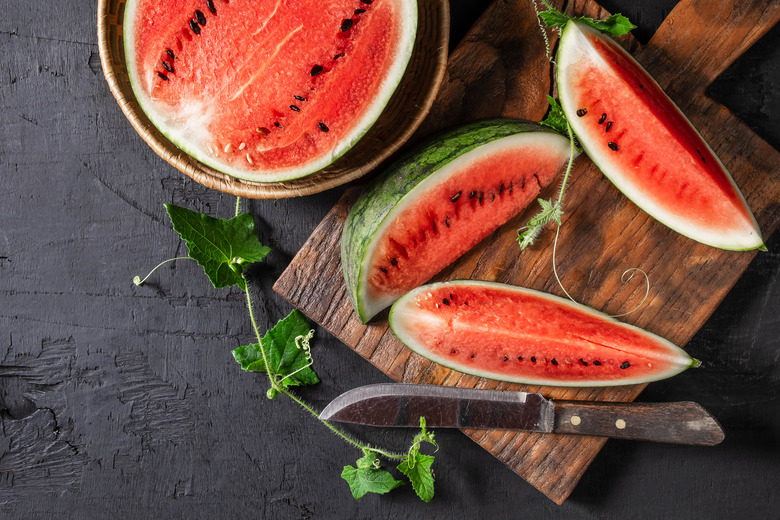How To Grow Ice Box Watermelons
Things Needed
- Icebox watermelon seeds
- Seed starter kit
- Potting soil
- Rototiller
- Garden rake
- Hoe
- Trowel
- Watering can or garden hose
- Mulch
The first ice box watermelons (Citrullus lanatus) were introduced to the United States more than a half century ago, but only began to be readily available during the last part of the 20th century. According to Washington State University, "icebox" simply is a weight designation; icebox watermelons weigh 6 to 15 pounds, while "personal" size melons are less than 6 pounds and picnic-size melons weigh more than 15 pounds. Icebox watermelon plant care is easy to do, and it will ensure you will be able to enjoy this juicy summer favorite from your own garden.
1. Choose Icebox Watermelon Seeds
Purchase icebox watermelon seeds. Pick Blacktail Mountain, Orchid Sweet, Southern Light, Early Crimson Treat or Navajo Sweet if you want an eight- to 10-pound watermelon. Choose Yellow Dell, Red Doll, Petite Perfection, Little Boy or New Queen if you would like a watermelon under eight pounds. For a departure from the typical red-fleshed watermelon, choose Sunshine, which the North Carolina State Extension notes has yellow flesh.
2. Start the Seeds Indoors
Sow icebox watermelon seeds indoors three to five weeks before the first frost. Place a seed into a seed starter kit filled with potting mix. Place one seed in each compartment, and cover it with soil to a depth of one inch, then water. Place the lid on the seed starter kit and set it in a brightly lit location, out of direct sun. When the icebox watermelon seeds sprout, remove the lid, place the kit in a sunny spot, and keep the potting mix moist but never sodden.
You can skip this step and direct-sow your icebox watermelon seeds in the garden after all threat of frost has passed.
3. Prepare the Planting Site
Choose an area with full sun and well-draining soil. Till the garden spot with a rototiller to remove weeds and grass from the soil. Rake the area with a garden rake to remove weeds and grass. Mark rows with a garden hoe by placing the edge of the hoe at the beginning of the row and dragging it in a straight line to the opposite end of the garden, keeping the depth of the row three to four inches. Mark parallel rows six feet apart from each other.
You can also grow icebox watermelon in raised beds if your garden soil is poor or doesn't drain well.
4. Transplant the Seedlings
Transplant the seedlings in your garden one to two weeks after the danger of first frost. Dig a hole one to two inches deep with a garden trowel. Place the seedling in the ground so the roots are below ground level, then cover the roots with dirt. Space each seedling three feet apart.
5. Keep Seedlings Watered
Water the watermelon seedlings with a watering can or garden hose. Start at the outside edge of the vine and work toward the base of the plant. Soak roots heavily with water every day or twice a day if you are experiencing extremely dry conditions.
6. Mulch Around Plants
Add a layer of pine bark, wood chips, leaves or pine straw around the watermelon plants. Place a three- to four-inch layer of material around the plants to conserve moisture and control weeds. Place a one- to two-inch-thick layer in between rows.
7. Harvest the Fruit
Harvest the fruit 65 to 75 days after planting. Check for fruit that is around six to 10 pounds, leaves that are deep green, and fruit that sounds hollow when it is thumped. Pick fruit at least twice a week by twisting the watermelon until it breaks free of the vine.
Warning
Check the seed packet to see if your variety if seedless. If so, it must be planted with seeded varieties for pollination purposes.
